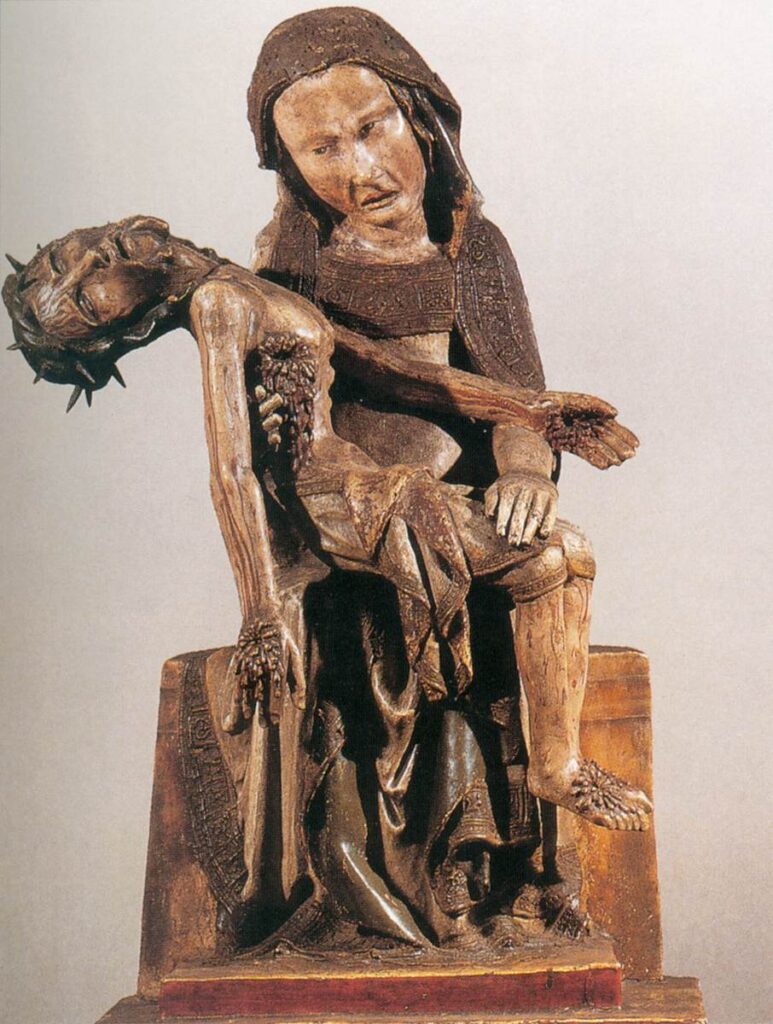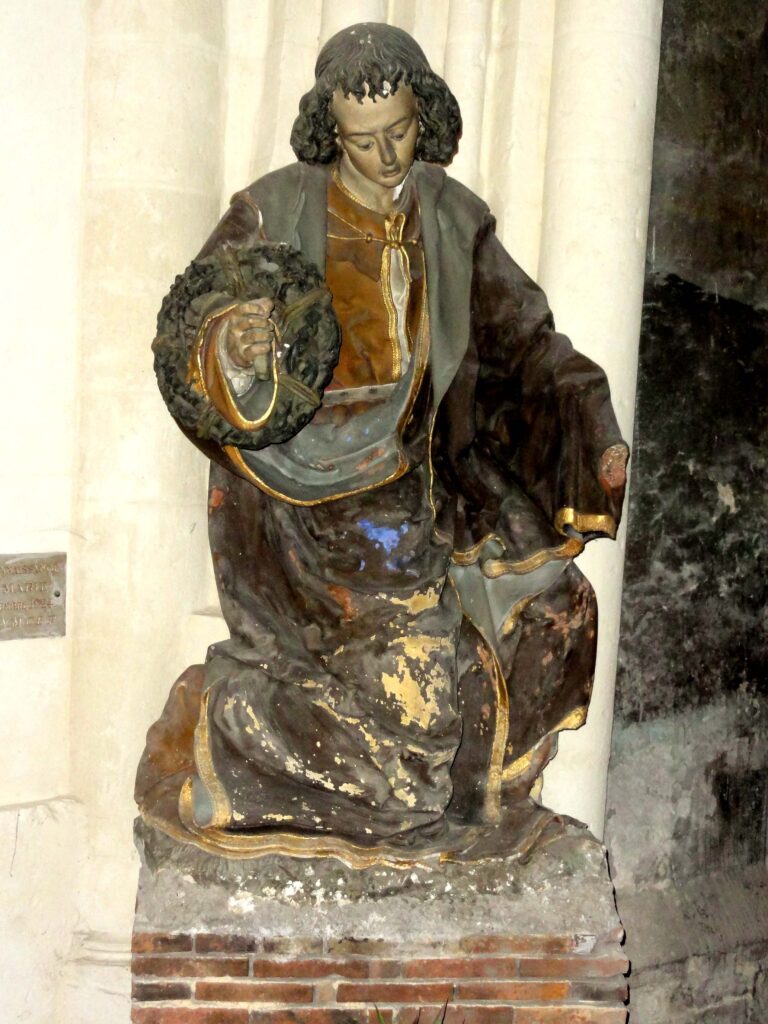People flock to Saint Peter’s in Rome to see Michelangelo’s iconic Pietà, but few know of the extraordinary Pietà made in 1526 by Jacques Jubert (or Joubert) in a relatively obscure French church. This polychrome statue is part of a larger sculptural group with John the Apostle and Mary Magdalene in Saint-Ayoul, Provins. Although cataloged with the historic monuments of France, the artist of this masterpiece, Joubert or Jubert, remains unknown. International visitors don’t often visit the church of Saint Ayoul, or the city of Provins, which is 90 kilometers from Paris. However, during the Middle Ages, Provins was a center of international trade, and home to the Counts of Champagne.
What strikes me about Jubert’s work is the beautiful curve of Jesus’ body with a limp, cusped arm. It’s an extraordinary composition.
The cross behind the sculpture also directs our attention, leading to Mary’s head. Mary’s face shows her devastation, and the viewer feels her pain. The gifted artist employed compositional devices, using curves and angles to enhance meaning. It is part of a larger Lamentation scene, explained below.
The Pietà was a theme popular in France and it was a French cardinal commissioned Michelangelo’s Pietà. An inscription in the church says that Jubert made the statue group for the leprosy hospital of Sainte-Colombe, near Provins.
Research into this artist, his background and his influences, would provide an excellent dissertation topic.

(The image of her face is found on media storehouse.)
Compared to Michelangelo’s Pietà


Left, Jacques Jubert, Pietà, 1526 Right, Michelangelo, Pietà, c. 1499
One wonders if the sculptor had seen Michelangelo’s marble masterpiece, completed about 25 years earlier. Jubert’s triangular composition and perfect balance conform to the Renaissance style. The anatomy is well done, but not as fine as Michelangelo’s, and limestone will never imitate the beauty of marble. The proportions work well too. Jesus’ arm lays limp and lifeless; the legs are crossed. But, unlike in the more famous sculpture by Michelangelo, Jesus’ body faces forward. Jubert followed French models in this respect, as if presenting the body of Christ to the world. Emotion is very strong in Mary’s face, and Christ’s wounds on the side and feet show blood.
Many Pietàs in France would have inspired Jubert, but his style, his composition, and his sense of unity are far more sophisticated than most. (Compare it a Pietà in New York’s Metropolitan Museum, c. 1515.) He may have known of the Michelangelo, but his sculpture is more open than Michelangelos’ closed pyramidal group. Both artists sculpted voluminous drapery! (I’m convinced that, if he did not go to Rome, he saw drawings of The Pietà.)
In Michelangelo’s Pietà, the very youthful Mary is serene and sad, but accepting. Her grief is in reserve. She knows that, because of His suffering and death, Christ’s mission could be accomplished. Michelangelo presents Jesus’ death as the perfect gift to humanity. Mary is proportionally much larger than Jesus in order to keep the figures within the perfect triangle.
A Gothic Pietà
At the other end of the spectrum are German works such as the Röttgen Pietà, with its great distortion and overwhelming emotionality. Made of wood, the Röttgen statue stands only 35 inches high (89 cm). It represents a different aesthetic and intends to force viewers to feel great pain and grief. Though it dates to c. 1300, late Gothic period, it reminds me of early 20th-century German Expressionism. In classes, I compare the Röttgen Pietà to Michelangelo’s. The contrasts are in style — as well as content. Mary’s large head is distorted to emphasize her unbearable suffering.

Röttgen Pietà, Germany, c. 1300-20
A Grieving Saint John and the Magdalene
Someone shared a magnificent photograph of the entire compositional group on Flickr. To the left of the central figures stands a grieving Saint John. Mary Magdalene flanks the scene on its right (see below, right). I think of the great textural contrasts of Bernini! She is elegant and beautiful, with magnificent long wavy hair. The figures of John and Mary follow the tradition of Deposition paintings and statues from Germany and the low countries, where contorted postures emphasize grief.
Jubert’s unknown masterpiece follows a French tradition depicting a painted city behind (Jerusalem? Istanbul?), as in the Avignon Pietà of 1450-60. Was it a different artist who painted the city, and how much of that painting is a restoration? Regardless, the planning that went into painting, sculpture and architecture was sophisticated, showing comprehensive spatial planning. It looks forward to the unified, multimedia 17th century installations of Bernini.
Other Information
The site of Saint-Ayoul contains both a parish church and a priory where monks lived and worshiped. A section of the priory is undergoing extensive renovation at present, revealing very old paintings from the Middle Ages.
Provins’ importance as a city diminished when Champagne came under the rule of the French kings. Information on Jacques Jubert is sparse, but an inscription in Saint-Ayoul indicates that he came from Troyes, another major commercial center of Champagne. The limestone came from Tonnerre in Burgundy.
The upper city of Provins holds a magnificent tower, Tour César, and Les Souterains, a series of underground crypts. Fortification walls flank two sides of it. In 2001, Provins gained the status as a UNESCO World Heritage site. Getting there from Paris by train takes one hour and twenty minutes.
One wonders what other masterpieces may be hidden in the countryside, or in the unknown churches of Europe.




Recent Comments